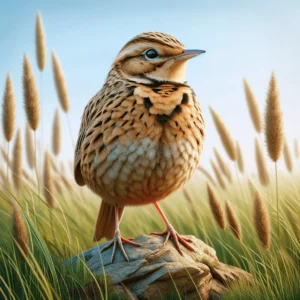When it comes to the diverse and captivating bird species found in Africa, one cannot overlook the Rufous-rumped lark. This fascinating bird, scientifically known as Pinarocorys erythropygia, is a small passerine that belongs to the Alaudidae family. With its distinctive features and unique behaviors, the rufous-rumped lark is a true marvel of nature.

The Appearance of the Rufous-rumped Lark
The rufous-rumped bird showcases a combination of colors that make it stand out from other bird species. It has a rufous-brown patch on its upper tail, which gives it its name. The rest of its plumage is predominantly sandy-brown, enabling it to blend perfectly with its arid habitat.
Measuring around 15–17 centimeters in length, the Rufous-rumped lark has a compact body with a slender bill. Its wings are relatively short and pointed, allowing for agile flight in open grasslands. With its small size and intricate patterns, this bird truly captivates birdwatchers and nature enthusiasts alike.
Habitat and Distribution
They are primarily found in the arid and semi-arid regions of Africa. It prefers dry grasslands, sandy plains, and open savannahs as its natural habitat. Countries like Namibia, Botswana, Zimbabwe, and South Africa are known to have a significant population of this bird species.
One of the reasons why the Rufous-rumped lark thrives in arid regions is its remarkable adaptation to the environment. It has the ability to survive in harsh conditions with limited water sources. Unlike many other bird species, this lark can go for extended periods without drinking water, obtaining most of its moisture from its food.
Behavior and Diet
The rufous-rumped bird is primarily diurnal and spends most of its time foraging on the ground. It has a distinctive hopping gait, moving from one patch of grass to another in search of insects, seeds, and small invertebrates. Its bill is perfectly suited for picking up these tiny prey items from the ground.
During the breeding season, the rufous-rumped bird engages in a beautiful display of courtship. The male performs elaborate flight displays, singing melodious songs while ascending high into the sky. This behavior is not only a way to attract a mate but also to assert its territory.

Breeding Habits
The rufous-rumped bird typically breeds during the rainy season, when there is abundant food and water available. The male establishes a territory and attracts a mate through its vibrant flight displays and melodious songs. Once a pair is formed, both the male and female work together to build a nest on the ground.
The nest of the Rufous-rumped lark is a simple structure made of dry grass, plant stems, and twigs. It is often well hidden amongst the vegetation, providing protection from predators and the harsh elements. The female then lays a clutch of two to four eggs, which she incubates for about two weeks.
After hatching, the parents take turns feeding and caring for the chicks. They diligently search for insects and small invertebrates to provide their young with the necessary nutrition. The chicks grow rapidly, and within a few weeks, they are ready to leave the nest and explore their surroundings.
The Conservation Status of the Rufous-rumped Species
Despite its adaptability and wide distribution, the rufous-rumped bird faces certain threats that have led to its declining population in some areas. Habitat loss due to human activities, such as agriculture and land development, poses a significant threat to this bird species.
In addition to habitat loss, the Rufous-rumped species is also vulnerable to predation by invasive species, such as feral cats and rats. These predators threaten the eggs, chicks, and even the adult birds, further impacting the population.
Recognizing the importance of preserving this unique bird species, conservation organizations are actively working towards protecting the Rufous-rumped bird and its habitat. Efforts include establishing protected areas, promoting sustainable land management practices, and raising awareness about the bird’s ecological significance.
The Importance of Preserving Its Natural Habitat
Preserving the natural habitat of the rufous-rumped bird has far-reaching benefits, not just for the bird itself but for the entire ecosystem. The savannahs and grasslands it inhabits are home to numerous other species, including mammals, reptiles, and other bird species.
By conserving the habitat, we ensure the survival of not just the rufous-rumped bird but also the diverse array of flora and fauna that rely on these ecosystems. It helps maintain ecological balance, supports biodiversity, and contributes to the overall health of the planet.
Conclusion
The rufous-rumped lark is undeniably a fascinating bird species from Africa. Its unique appearance, adaptations to arid habitats, and captivating behaviors make it a true wonder of nature. However, it is important for us to recognize the threats it faces and take action to protect its habitat.
Preserving the natural environment where the Rufous-rumped lark thrives not only safeguards its existence but also contributes to the preservation of biodiversity and the overall health of our planet. Let us appreciate the beauty of this marvelous bird and work together to ensure its future generations can continue to grace us with their presence.
